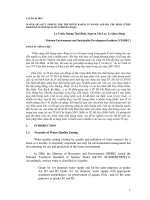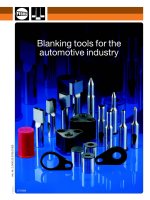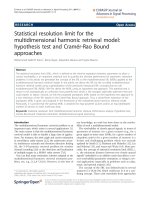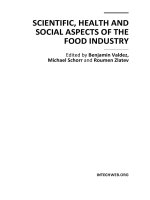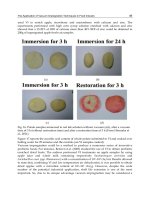statistical quality control for the food industry
Bạn đang xem bản rút gọn của tài liệu. Xem và tải ngay bản đầy đủ của tài liệu tại đây (15.67 MB, 360 trang )
Statistical Quality
Control
for the
Food Industry
Third
Edition
Merton
R.
Hubbard
Consultant,
Hillsborough,
California
Kluwer
Academic
/
Plenum Publishers
New
York,
Boston, Dordrecht, London, Moscow
Library
of
Congress
Cataloging-in-Publication
Data
Hubbard,
Merton
R.
Statistical quality control
for the
food
industry/Merton
R.
Hubbard—3rd
ed.
p.
cm.
Includes
bibliographical references
and
index.
ISBN
0-306-47728-9
1.
Food industry
and
trade—Quality
control.
I.
Title.
TP372.6.H83
2003
664'.07—dc21
2003047710
ISBN
0-306-47728-9
Copyright
©
2003
by
Kluwer
Academic/Plenum Publishers,
New
York
233
Spring Street,
New
York,
New
York
10013
http:
//www.
wkap.
nl/
10
987654321
A
C.I.P.
record
for
this book
is
available
from
the
Library
of
Congress.
All
rights reserved
No
part
of
this work
may be
reproduced,
stored
in a
retrieval
system,
or
transmitted
in any
form
or by any
means, electronic, mechanical, photocopying, microfilming, recording,
or
otherwise,
without
written permission
from
the
Publisher, with
the
exception
of any
material supplied
specifically
for the
purpose
of
being entered
and
executed
on a
computer system,
for
exclusive
use by the
purchaser
of the
work.
Permissions
for
books published
in
Europe:
Permissions
for
books published
in the
United States
of
America:
Printed
in the
United States
of
America
Preface
to the
Third
Edition
Since
the
second edition
of
Statistical
Quality
Control
for the
Food
Industry
was
printed,
the
statistics involved
in the
quality control
of
food
has not
changed.
Sigma
is
still sigma;
the
mean remains
the
mean. There have been some signifi-
cant
changes however
in
philosophies, particularly
in the
areas
of
quality manage-
ment
and
food
quality standards.
The
Baldridge National Quality Program
has
moved another step
away
from
the
goal
of
product quality control
by
emphasizing
business
excellence
as the
major
criteria
for the
Baldridge Award.
As the
U.S.
imports moved
from one
foreign country
to
another,
the
changing
quality
of
imported manufactured goods
in
addition
to the
cost
of
foreign manu-
facture
has
substantially
affected
the
U.S. national debt.
The
major
changes
in ISO
9000 have resulted
in two
major
concerns:
(1) Do the
currently
certified
processors have
to be
recertified?
and (2)
Since
the
ISO9000:2000
differs
in so
many areas, does that mean that
the
quality control procedures
of the
last
five
years were incorrect?
The
success
of
many companies
in
meeting quality standards using
the
HACCP
principles
has
been recognized
by the
FDA.
As a
direct result,
the FDA
is
increasing
the
number
of
food
products which must
be
produced using
the
HACCP
principles.
It
should
be
noted that
the FDA
regulations
are
concerned with
food
safety,
rather than
food
quality,
and
this
is
reflected
in the new
regulations.
The
need
for
statistical quality control principles
are
still required
to
meet
a
pro-
ducer's needs
for
other critical
food
characteristics
not
included
in the
HACCP
regulations
(flavor,
color, etc).
Considerable
publicity
for the
six-sigma
quality control system
has
suggested
that conventional statistical quality control procedures
are
outmoded. This
might
be
true
in
hardware manufacturing industries where warranties, returns,
and
repairs
are
part
of the
system,
but
certainly
not in the
food
industries. However,
there
are
some parts
of the
six-sigma
approach which might
be of
value
to the
food
industry
as
well.
The
Net
Content Control regulations have been modified somewhat,
but the
statistical approach
to
compliance remains essentially unchanged.
All of the
above changes
in the
food
industry quality control procedures
are
discussed
in
this third edition.
Preface
to the
Second
Edition
Within
the six
years since
the
first
edition
was
published,
ISO
9000, HACCP,
Expert Systems,
six-sigma,
proprietary vendor certification programs,
sophisti-
cated team techniques, downsizing,
new
electronic
and
biochemical laboratory
methods, benchmarking, computer-integrated management,
and
other techniques,
standards,
and
procedures descended upon
the
quality control managers
in the
food
industry with
the
impact
of a
series
of
tornados. Everything changed;
it was
time
to
rewrite Statistical
Quality
Control
for the
Food
Industry.
Or so it
seemed. But,
as it
turns out, everything
has not
changed.
The
concepts
of
variability, sampling,
and
probability
are
still
the
same.
The
seven basic tools
of
statistical quality control still work. Control charts still supply
the
information
to
control
the
process—although
now the
computer
is
doing most
of the
calcula-
tions
and
graph construction faster,
and in
color.
On
close examination, even some
of the
major
developments
are not
really
all
that
new.
For
example,
ISO
9000 closely resembles
Food
Processing
Industry
Quality
System
Guidelines
published
in
1986,
and
some other quality systems.
The
powerful
Hazard Analysis Critical Control Point technique
has
also been around
for
some time,
and
many
food
companies have been using selected portions
of it
voluntarily.
Now, however,
it has
become part
of the
food
laws
and has
suddenly
received widespread publicity.
There
have been some real changes, however.
The
power
of the
computer
has
been applied
to
several phases
of the
food
industry: Management
has
found
that
some computer applications
can
reduce
the
need
for
manpower. Other com-
puters have been harnessed
to
processes
to
receive electrical information, analyze
the
input,
and
instantly send adjustment signals
back—thus
improving
the
process
by
reducing variability. Some have been used
to
instantly provide
expert process advice
to the
operator. Still others have been used
to
extract data
from
process computers,
and to
analyze, calculate,
and
produce graphs, charts,
and
reports
for
product
and
process improvement studies
for
immediate
use by all
interested departments.
Considering
the
ability
of
food
processing
companies
to
consistently
manufacture
safe
foods
with
uniform
quality over
the
past
20 or 30
years
without
these
new
tools
and new
systems,
one
might expect that quality control improve-
ments would
be
marginal.
On the
other
hand,
these changes have already provided
substantial opportunities
for
process
and
product improvement. This second edition
is
intended
to
update
the
basic concepts
and
discuss some
of the new
ones.
Preface
to the
First
Edition
If
an
automobile tire leaks,
or an
electric light switch
fails,
or we are
short-changed
at a
department store,
or are
erroneously billed
for
phone calls
not
made,
or a
plane departure
is
delayed
due to a
mechanical
failure—these
are
fairly
ordinary
annoyances, which
our
culture
has
come
to
accept
as
normal occurrences.
Contrast this with
a
failure
of a
food
product.
If
foreign matter
is
found
in a
food,
if the
product
is
discolored
or
crushed
or
causes illness
or
discomfort when
eaten,
the
consumer reacts with anger,
fear,
and
sometimes mass hysteria.
The
offending
product
is
often
returned
to the
seller,
or a
disgruntled letter
is
written
to the
manufacturer,
or at
worst,
an
expensive
law
suit
may be
filed
against
the
company.
The
reaction
is
almost
as
severe
if the
failure
is a
difficult-to-open
pack-
age or a
leaking container. There
is no
tolerance
for
failure
of
food
products.
Dozens
of
books
on
quality written
for the
hardware
or
service industries dis-
cuss
failure
rates, product reliability, serviceability, maintainability, warranty,
and
repairs.
Manufacturers
in the
food
industry
do not use
these measurements since
food
reliability must
be
100%,
failure
rate must
be 0%;
serviceability, maintain-
ability,
warranty,
and
repairs
are
meaningless.
Consequently, this book
on
food
quality does
not
concern
itself with reliabili-
ty
and
safety.
It is
assumed that manufacturers
in the
food
industry recognize
the
intolerance
of
their customers
and the
rigid requirement
of
producing
100%
safe
and
reliable product. Those
few
food
processors
who
experienced
off-flavor,
for-
eign
material, salmonella, botulism,
or
other serious
defects
in
their products
rarely survive.
What
the
book does cover
are the
various techniques which assure
the
safe
production
of
uniform
foods.
All of the
subjects covered
are
specifically tied
to
food
industry applications.
The
chapter
on
fundamentals
of
statistics
is
made
palatable
by the use of
examples taken directly
from
companies processing
fruits,
wine, nuts,
and
frozen
foods.
Many other
food
product examples
are
used
to
illus-
trate
the
procedures
for
generating control charts.
By
now, most upper managers
are
aware that process control
is a
technique
which
long
ago
supplanted
the
"inspect
and
sort"
concept
of
quality control. This
book
is
intended
to
present upper managers with
an
understanding
of
what
the
technique includes.
It is
also targeted
at the
quality engineers, managers,
and
tech-
nicians
who
have been unable
to
find
workable explanations
for
some
of
those
quality
techniques specifically used
by the
food
industry.
A new
audience
for
this
subject
includes
all of the
departments
in
companies, embracing
the
concept
of
total quality control. Here
is a
collection
of
quality techniques that accounting,
procurement, distribution, production, marketing,
and
purchasing
can
apply
to
their
departments. Finally,
the
book
is
aimed
at
students hoping
to
enter
the
field
of
food
quality control,
and
technicians
who are
aspiring
to
management
posi-
tions
in
quality control.
Guidelines
for
overall quality control systems
and
suggestions
for
implement-
ing
a
quality control program
are
discussed
from
a
generic point
of
view.
All of the
other subjects
are
very specific "how
to"
discussions.
For
example,
an
entire chap-
ter is
devoted
to a
step-by-step procedure
for
controlling
the net
quantity
of
pack-
aged
foods.
It
explains
how to
obtain data, interpret government weight regulation,
calculate both
the
legal
and
economic performance,
and set
target weights.
For the
most part,
the
calculations have been reduced
to
simple arithmetic.
Where possible, each chapter subject
has
been designed
to
stand alone.
As an
example,
the
chapter
on
process control explains
how
charts
are
interpreted
and
what
actions should
be
taken. While reading this chapter
on
process control,
it is
not
necessary
to
thumb through
the
pages
to
consult
the
Appendix tables
or the
chapter
on
methods
for
preparing control charts. Similarly,
the
design
of
experi-
ments section uses some
of the
concepts introduced earlier,
but
does
not
require
the
reader
to
review
the
chapter
on
fundamentals.
The
subject
of
experimental
design
is
complex,
but the
book reduces
it to
straightforward explanation
and
provides
food
processing examples,
as
well
as a
series
of
diagrams
of the
most
useful
designs.
The
bibliography contains most
of the
common texts
on
statistical
process
control.
In
addition,
the
chapter
on
test methods provides
a
list
of
references,
which
have
food
industry applications.
The
Appendix tables include only those
referred
to in
this book.
The
author
has
attempted
to
avoid theories
and
generalities
in
order
to
make
this
book
as
practical
and
useful
as
possible.
In the
immense
field
of
food
pro-
cessing,
it is
remarkable
how
little specific quality control information
has
been
available.
It is
hoped that this book will
fill
that gap.
Acknowledgments
The
need
for a
book
of
this scope became apparent during
the
annual
presenta-
tions
of
Statistical Process Control Courses
for the
Food Industry, sponsored
by
the
University
of
California, Davis, California.
I am
primarily
grateful
to
Robert
C.
Pearl,
who
spearheaded these quality control courses since
the
early
1960s,
and
to
Jim
Lapsley,
his
successor,
for
their continuing support during this
book's
development.
Many
University
staff
and
quality professionals have contributed
to the
prepa-
ration
and
instruction
of
these courses,
and I
must give special thanks
to the
following
for
permission
to
include portions
of
their unpublished notes
in
various
sections
of the
book:
Professor
Edward Roessler Wendell Kerr
Dr.
Alan
P
Fenech Chip
Kloos
Sidney Daniel Ralph Leporiere
Ronnie
L. De La
Cruz
Jon
Libby
Seth
Goldsmith Donald
L.
Paul
Randy Hamlin Sidney Pearce
Gilbert
F.
Hilleary Floyd
E.
Weymouth
Mary
W.
Kamm
Tom
White
Thanks
to the
Longman Group
for
permission
to
reprint Table XXXIII
from
the
book Statistical
Tables
for
Biological,
Agricultural
and
Medical
Research,
6th
Edition, 1974,
by
Fisher
and
Yates.
Thanks
are
also
due to my
wife
Elaine
for her
professional help
as my
editor,
and
for her
encouragement
and
patience over
the
long haul.
v
This page has been reformatted by Knovel to provide easier navigation.
Contents
Preface to the Third Edition ix
Preface to the Second Edition xi
Preface to the First Edition xiii
Acknowledgments xv
1. Introduction 1
Variability 2
Quality Control Programs 3
Problems with Tool Selection 8
Quality Control Tools 8
2. Food Quality System 15
The Formalized Quality System 15
Quality System Guidelines 16
Malcolm Baldridge National Quality Award 27
Total Quality Management 28
Team Quality Systems 30
Computer Network Quality Systems 30
Summary 30
3. Control Charts 49
The Importance of Charting 49
vi Contents
This page has been reformatted by Knovel to provide easier navigation.
Procedure for Constructing X-Bar and R Charts 53
Procedures for Constructing Attribute Charts 57
4. Fundamentals 71
Analysis of Data 71
Probability 76
Binomial Distribution 78
The Normal Distribution 82
Distribution of Sample Means 84
Normal Approximation to the Binomial Distribution 90
t-Distribution 92
Confidence Limits for the Population Mean 93
Statistical Hypotheses – Testing Hypotheses 95
Distribution of the Difference between Means 100
Paired Observations 103
F-Distribution 104
Analysis of Variance 105
Two Criteria of Classification 111
5. Sampling 115
Sampling Plans 115
Why Sample? 116
Samples from Different Distributions 117
Sample Size 118
How to Take Samples 123
Types of Samples 128
Sampling Plans 131
Types of Inspection 131
Classes of Defects 132
Sampling Risks 135
Selection of Population to be Sampled 136
Contents vii
This page has been reformatted by Knovel to provide easier navigation.
Selection of Sample Frequency and Location 137
Hazard Analysis Critical Control Point 138
Attribute Sampling Plans 149
6. Test Methods 151
General Analysis 153
Special Instrumentation 153
Microbiology 153
Sensory 153
7. Product Specifications 157
8. Process Capability 163
Capability Index 170
Benchmarking 173
9. Process Control 177
Chart Patterns 179
Using the Control Chart as a Quality Management
Tool 184
10. Sensory Testing 187
The Senses 188
Sensory Testing Methods 189
Types of Panels 194
Selection and Training 197
11. Net Content Control 201
Evaluation of Net Content Performance 205
Interpreting Net Content Control 205
Procedures for Setting Fill Targets 213
viii Contents
This page has been reformatted by Knovel to provide easier navigation.
12. Design of Experiments 219
Introduction 219
Elimination of Extraneous Variables 222
Handling many Factors Simultaneously 226
Full Factorial Designs 227
Fractional Factorial Designs 232
Response Surface Designs 236
Mixture Designs 239
Experimental Design Analysis by Control Chart 248
13. Vendor Quality Assurance 253
Vendor-Vendee Relations 255
Specifications for Raw Materials, Ingredients, Supplies 257
Quality Assurance of Purchased Goods 259
Selecting and Nurturing a Supplier 263
Packaging Supplier Quality Assurance 266
Supplier Certification Programs 271
14. Implementing a Quality Control Program 275
Management Commitment 275
Getting Started 276
An In-House Program 277
Team Quality Systems 279
Stepwise Procedures for Team Problem Solving 282
Programs without Management Support 284
Training Quality Control Technicians 287
Summary 288
15. The Computer and Process Control 289
Computer Integrated Management 289
Artificial Intelligence and Expert Systems 291
Contents ix
This page has been reformatted by Knovel to provide easier navigation.
Computer-Controlled Processing 294
Summary 307
16. Six-Sigma 309
Summary 313
Appendix 315
References 335
Index 339
1
Introduction
In
2002,
the
United States balance
of
trade with East Asia
was
negative
$171,593,000.
The
prices were
not
necessarily lower than
for
merchandise pro-
duced
in the
United States,
but the
quality level
and
uniformity were
excellent—
a far cry
from
the
shoddy reputation
the
Orient
suffered
throughout
the
first
half
of
the
20th century. This
has
raised
fears
that
the
Orient would ultimately take
over
the
production
of all of our
products,
and
that
the
United States
has
already
turned into
a
service-industry nation. Statisticians have been known
to
generate
analyses
that
are
mathematically correct,
but
which occasionally
are
open
to
question
if the
data
are
presented
out of
context.
The
171
billion
dollars
may
fall
into
that category. There
is no
question that
the
171
billion dollars represents
a
sizeable quantity
of
goods;
but the
yearly
US.
Gross National Product (GNP)
in
the
early
200Os
was
10
trillion dollars. This means that imports
from
East Asia
accounted
for
only 1.7%
of our
GNP. Less than
2%
does
not
seem
to be a
dan-
gerously high
level—certainly
not
high enough
to
suggest that
we are in
danger
of
having
all of our
products manufactured elsewhere.
Government statisticians have replaced
GNP
with Gross Domestic Product
(GDP),
but
there
is
only
a
small
difference
between these figures. Perhaps
the
1.7%
figure might
be
overly pessimistic, because trade imbalances have
built-in
correcting devices.
For
example, during periods when domestic consumption
slows, imports will slow
as
well. U.S. exports during
the end of the
century were
actually growing
at a 25%
annual rate,
and
trade deficits with
foreign
countries
had
peaked. This improvement
was
masked
by the
fluctuating value
of the
dollar against
foreign
currencies. (Merrill Lynch Global Investment Strategy,
21
March 1995; also
the
Japan Business Information Center; Keizai Koho
Center.)
The
quality control
and the
quality level
in the
United States
are not
necessarily
inferior,
as
implied
by the
cold numbers. Perhaps
the
impression that
our
manu-
facturing
industry
is
about
to be
taken over
by the
Orient
is due to
their selection
of
some highly visible consumer products. They have done
an
excellent
job of it
in
photography, optics, electronics
and the
auto industry.
But
even
in
these areas,
the
United States still maintains
a
significant number
of
profitable operations
with notable market share.
Food production
and
processing
in the
United States
is an
area
of
outstanding
quality, unmatched
by the
Orient.
The
most
obvious example
of
food
quality con-
trol
is the
safety
of
foods
in the
United States. There
are 290
million people
in
this
country
who eat a
total
of
about
870
million meals
a
day,
or 318
billion meals
annually.
A
benchmark study made
by the
Center
for
Disease
Control analyzed
the
numbers
and
causes
for
food
outbreaks across
the
country
for an
entire year.
They
found
460
reported outbreaks
of
food
poisoning,
in
which
an
outbreak
was
defined
as two or
more people becoming
ill
from
the
same
food
eaten
at the
same
time.
The 460
figure represents
the
number
of
people
who
were reported
by
Public Health Departments, doctors,
and
hospitals
to
have become
ill
from
foods
during
the
year,
but
does
not
include those
who
became
ill and who
went
to
their
own
physician
for
treatment
or
waited without assistance until they recovered.
Of
course, such data
is
unavailable. Working only with
the
proven data,
the 460
figure,
expressed
as
percent product
failure,
indicates
(460
X
100)7318,000,000,000
=
0.000000147%
It is
difficult
to
find
another country which
has
achieved that kind
of
record
for
any
product
in any
industry.
If the
record
for
food
quality
is so
superb,
why
this book? Because
the
need
to
improve quality control
is
unending.
The
safety
appears adequate,
but
there
are
always
improvements
possible
in net
weight control, product color,
flavor,
keep-
ing
qualities, production cost, absence
of
defects,
productivity, etc. There still
is
little
factual
quality information provided
at the
graduate level
of
business
schools,
and
much
of the
information available
to the
management
of
food
pro-
cessing companies
is
supplied
by the
professionals
in
quality control
who are
likely
to
read this book. Perhaps management
may
find
the
time
to
read
it as
well.
VARIABILITY
We
live
in a
world
of
variability.
The
person
who
first used
the
expression
"like
two
peas
in a
pod"
was not
looking very
carefully.
There
are no two
people
exactly
alike—even
so-called twins. Astronomers tell
us
that
in
this vast universe,
there
are no two
planets alike.
Two
man-made products which
are
"within
speci-
fications"
may
seem
to be the
same,
but on
closer inspection,
we
find
that they
are not
identical.
It is
generally known that perfection
is not
possible.
You
know
it,
your
friends
know
it,
children know
it; but the
Chief Operating
Officer
of
many companies
does
not
admit
to it. He
says that there
is no
reason
why all
products
in a
properly
maintained production
line—with
adequately trained
and
motivated workers,
the
right
raw
materials,
expert
supervisors,
and
quality control employees
who
know
what they
are
doing—cannot
be
perfectly uniform, with
no
defects,
and
with
no
variation. While
we
must
accept
the
fact
that variability does exist, there
are
methods
to
control
it
within bounds which will
satisfy
even
the
Chief
Operating
Officer.
You
will
find
that:
•
Statistical tools
are
available
•
Processes
can be
controlled
•
Line people
are not
necessarily responsible
for
poor quality
•
Management,
and
only management
can
improve quality
QUALITY
CONTROL
PROGRAMS
The
Shewhart
control-chart technique
was
developed
in
1924,
and has
been
in use
continuously since then. Perhaps
the
only
fundamental
change
in the
Shewhart
chart
was the
simplification evolved
by
mathematical statisticians
by
which con-
trol charts could
be
simply determined using
the
range
of
observations, rather
than
the
more time-consuming calculations
for
standard deviations
for
each sub-
group.
Evaluation
of the
statistical approach
of
Shewhart
was
published
in
1939
by
WE.
Deming,
who
later (1944) defined "constant-cause systems, stability,
and
distribution"
in
simple terms
to
show
how a
control chart determined when
a
process
was in
statistical control.
After
over
50
years, these principles
are
still
valid,
and are the
basis
for
most
of the
successful quality control programs
in use
today.
One of the
philosophies attributed
to Dr.
Deming
is
that judgment
and the
eyeball
are
most always wrong.
X-bar,
R
and/?
charts
are the
only evidence that
a
process
is in
control. Failure
to use
statistical methods
to
discover which type
of
cause (common
or
system cause;
and
special
or
assignable cause)
is
responsible
for
a
production
problem
generally
leads
to
chaos;
whereas
statistical
methods,
properly
used,
direct
the
efforts
of all
concerned toward productivity
and
quality.
Dr.
Deming
has
stated that
85% of the
causes
of
quality problems
are
faults
of
the
system (common causes) which will remain with
the
system until they
are
reduced
by
management. Only
15%
of the
causes
are
special
or
assignable causes
specific
to an
individual machine
or
worker,
and are
readily detectable
from
statistical signals.
Confusion
between common
and
assignable causes leads
to
frustration
at all
levels,
and
results
in
greater variability
and
higher
costs—the
exact opposite
of
what
is
needed. Without
the use of
statistical techniques,
the
natural reaction
to an
accident,
a
high
reject
rate,
or
production stoppage
is to
blame
the
operators.
The
worker
is
powerless
to act on a
common cause.
The
worker
has no
authority
to
sharpen
the
definition
and
tests that determine what constitutes acceptable
quality.
He
cannot
do
much about test equipment
or
machines which
are out of
order.
He
cannot change
the
policy
or
specifications
for
procurement
of
incoming
materials,
nor is he
responsible
for
design
of the
product.
Several quality control leaders have each developed
a
formalized program
consisting
of
several steps.
It is
difficult
to
look
at a
summary
of
these steps
to
determine which system
is
best
for a
given company, since
the
programs must
be
tailored
to
each particular situation. Note
how
even these recognized authorities
disagree
on
certain measures.
A
summary
of the
steps suggested
by
these quality
control
authorities follows. They
are not
complete descriptions,
but
serve
to
differentiate
the
emphasis
of
these programs.
J.M.
Juran
1.
Establish quality policies, guides
to
managerial action.
2.
Establish quality goals.
3.
Design quality plans
to
reach these goals.
4.
Assign responsibility
for
implementing
the
plans.
5.
Provide
the
necessary resources.
6.
Review progress against goal.
7.
Evaluate manager performance against quality goal.
W.E. Deming (Quality
Magazine
Anniversary Issue 1987)
1.
Create constancy
of
purpose toward improvement
of
product
and
services.
2.
Adopt
the new
philosophy:
we are in a new
economic age.
3.
Cease dependence
on
mass inspection
as a way to
achieve quality.
4.
End the
practice
of
awarding business
on the
basis
of
price tag.
5.
Constantly
and
forever
improve
the
system
of
production
and
service;
the
system
includes
the
people.
6.
Institute training
on the
job.
7.
Provide leadership
to
help people
and
machines
do a
better job.
8.
Drive
out
fear.
9.
Break down barriers between departments.
10.
Eliminate slogans
and
targets
for
zero
defects
and new
productivity levels.
11.
Eliminate work standards
and
management
by
objectives.
12.
Remove barriers that
rob
people
of
their right
to
pride
of
workmanship.
13.
Institute
a
vigorous program
of
education
and
self-improvement.
14.
Put
everybody
in the
company
to
work
to
accomplish
the
transformation.
Armand
V.
Fiegenbaum
1.
Agree
on
business decision
at the
boardroom level
to
make quality lead-
ership
a
strategic company goal
and
back
it up
with
the
necessary budgets,
systems,
and
actions. Each
key
manager must personally assess perform-
ance, carry
out
corrective measures,
and
systematically maintain
improvements.
2.
Create
a
systemic structure
of
quality management
and
technology. This
makes quality leadership policies
effective
and
integrates agreed-upon
quality
disciplines throughout
the
organization.
3.
Establish
the
continuing quality habit. Today's programs seek continually
improving
quality levels.
Tom
Peters
1.
Abiding management commitment.
2.
Wholesale empowerment
of
people.
3.
Involvement
of all
functions—and
allies
of the
firm.
4.
Encompassing
systems.
5.
Attention
to
customer perceptions more than technical specifications.
RB.
Crosby
(Quality
is
Free
by RB.
Crosby)
1.
Management commitment.
2.
Quality improvement team.
3.
Quality measurement.
4.
Cost
of
quality evaluation.
5.
Quality awareness.
6.
Corrective action.
7.
Establish
an Ad Hoc
committee
for the
Zero
Defects
Program.
8.
Supervisor training.
9.
Zero
defects
day.
10.
Goal setting.
11.
Error cause removal.
12.
Recognition.
13.
Quality councils.
14.
Do it all
over again.
M.R.
Hubbard
(N.
CaI. Institute
of
Food Technologists
October 1987)
1.
Select
an
area within
the
company
in
need
of
assistance, using Pareto
or
political procedures.
2.
Using statistical techniques, calculate process capability
and
determine
control limits.
3.
Establish sampling locations,
frequency,
size,
and
methods
of
testing
and
reporting. Study process outliers
and
determine assignable causes
of
variation
at
each process step.
4.
Correct assignable causes
by
modifying
the
process,
and
calculate
improved
process capability. Report
to
management dollars
saved,
improved
productivity, reduced scrap, rework, spoilage, product giveaway,
overtime,
etc.
5.
Repeat steps
3 and 4
until
no
further
improvements
are
apparent.
6.
Design experiments
to
modify
the
process
to
further
improve productivity,
and
follow
by
returning
to
step
2,
using
the
most promising
test
results.
7.
Move
on to
another area
of the
company (another line, another
function,
another department) until
the
entire
company
is
actively pursuing quality
programs.
8.
Where possible, install quality attribute acceptance sampling plans
as a
safeguard
for
quality
in the
process
and in the
finished product. Expand
this
into
a
company-wide audit system.
Total
Quality Management Practices (General Accounting
Office
1991)
1.
Customer-defined quality.
2.
Senior management quality leadership.
3.
Employee involvement
and
empowerment.
4.
Employee training
in
quality awareness
and
quality skills.
5.
Open corporate culture.
6.
Fact-based quality decision-making.
7.
Partnership with suppliers.
Hazard Analysis Critical Control Point (Department
of
Health
and
Human
Services—FDA,
1994-2002)
1.
Identify
food
safety
hazards.
2.
Identify
critical control points where hazards
are
likely
to
occur.
3.
Identify
critical
limits
for
each hazard.
4.
Establish monitoring procedure.
5.
Establish corrective actions.
6.
Establish
effective
record keeping procedures.
7.
Establish
verifying
audit procedures.
Computer
Integrated Management (approximately
1987)
Computer
integrated management
(CIM)
is a
system designed
to
control
all
phases
of a
food
process
by the use of
computers.
The
goal
is to
utilize computer
power
in
product design, engineering, purchasing,
raw
material control, produc-
tion
scheduling, maintenance, manufacturing, quality control, inventory control,
warehousing
and
distribution, cost accounting,
and
finance.
By
integrating
the
databases
and
commands
of the
individual computer systems throughout
all of
these stages,
it
should
be
possible
to
improve
the
efficiency
of
production plan-
ning
and
control, decrease costs
of
each operation,
and
improve both process
con-
trol
and
product quality.
The
goal
is to
optimize
the
entire system through
the use
of
computerized information sharing.
ISO
9000 Standards (International Organization
for
Standardization revised 2000)
1.
ISO
9000. Quality Management
and
Quality Assurance
Standards—
Guidelines
for
Selection
and
Use.
The
2002 emphasis
shifted
further
from
product quality control toward business
performance
excellence.
The
Examination categories
for
2002 were:
•
Leadership
•
Strategic planning
•
Customer
and
market
focus
•
Information
and
analysis
•
Human resource
focus
•
Process management
•
Business results.
Although these business goals
are
admirable, they have
failed
to
emphasize
the
goal
of
quality control.
Six-Sigma (Motorola
1979)
(see Chapter
16)
•
Recognize
•
Define
•
Measure
•
Analyze
•
Improve
•
Control
•
Standardize
•
Integrate.
2. ISO
9001.
Quality
Systems—Model
for
Quality Assurance
in
Design/
Development, Production, Installation,
and
Servicing.
3.
ISO
9004. Quality Management
and
Quality System
Elements—Guidelines.
Malcolm Baldridge
National
Quality Award (U.S. Department
of
Commerce
1987,
and
revised
annually)
The
seven categories
on
which these quality awards
are
based have been revised
over
the
years. Three years have been selected
at
random
as
examples.
1990
Examination
categories
1.
Leadership
2.
Information
and
analysis
3.
Strategic
quality
planning
4.
Human resources utilization
5.
Quality assurance
of
products
and
services
6.
Quality results
7.
Customer satisfaction
1
995
Examination categories
Leadership
Information
and
analysis
Strategic
planning
Human resource development
and
management
Process management
Business results
Customer focus
and
satisfaction
The
Six-Sigma process
is
often
called
the
DMAIC system,
referring
to the
steps
2-6
above.
The
system
is
explained
in
detail
in
Chapter
16.
Other Quality Programs
Since
the
1980s, several additional techniques have been
offered
with
the
goal
of
improving
quality control programs.
For the
most part, they
are
business process
tools rather than statistical quality control techniques,
but
have
often
had
favorable
effects
on
both productivity
and
product quality. Some
of the
many examples:
Total
Quality Management, Teams,
Reengineering,
Benchmarking, Empowerment,
Continuous
Improvement, Quality Function Deployment, Computer Applications,
Six-Sigma,
Computer Controlled Processes, Computer Analyses
of
Data,
Computerized
SPC,
Real Time
Manufacturing,
Expert Systems,
etc.
PROBLEMS WITH TOOL SELECTION
The
difficulty
in
selecting
the
correct statistical tools
for
problem solving might
be
explained using
the
analogy
of
selecting
the
correct tools
for a
painting
project.
Assume that
we
wish
to
paint
a
rod.
We are
faced
with
the
following
choices:
5
finishes:
flat,
satin
flat,
satin, semigloss, gloss
3
solubilities: oils, water, organic solvents
5
types: lacquers, enamels, stains, primers,
fillers
4
spreaders:
air and
pressure spray, roll, brush,
gel
brush
Although
all of
these possibilities
are not
necessarily combinable, there
is a
possibility
of at
least
5X3X5X4
=
3
OO
combinations
of
kinds
of
paints
and
applicators
This does
not
include
all
paint types,
or the
myriad
of
shades available.
Nor
does
it
consider
the
formulations
for floor,
ceiling, deck, wall,
furniture,
concrete,
metal, glass, antifouling,
etc.
Nor
does
it
include subclasses
of
metals: iron,
gal-
vanized,
copper, aluminum,
etc.
Knowing which tools
are
available
may not
solve
our
painting problem.
Any
paint will cover
wood,
concrete,
or
some metals,
but
will
it
peel, blister,
fade,
discolor, weather, corrode,
flake, or
stain? Will
it
leave
brush marks,
or a
slippery
surface?
Is it
toxic? Does
it
have
an
unpleasant odor?
Will
it
resist
a
second coat?
In
short, knowing which tools
are
available
is
neces-
sary;
and
knowing
the
proper
use of
these tools
is
absolutely imperative.
QUALITY
CONTROL TOOLS
The
following
is a
list
of the
more common statistical tools used
in
quality
control applications. These will
be
covered
in
greater detail later. These tools have
Statistical
tool
Acceptance sampling plans
Analysis
of
variance
Cause
and
effect
chart
Confidence
limits
Check
sheet
Control
charts
Cusum
chart
Design
of
experiments
Evolutionary operation
Flow
chart
Histogram
Pareto
chart
Probability distributions
Process
capability
Regression
analysis
Sample
size probabilities
Scatter
diagram
Statistical inference
Taguchi
method
Trend
chart
Use
Evaluate product attribute quality
Establish significance
of
difference
between
two
sets
of
data
Display sources
of
problems
Determine
reliability
of
sample results
Locates
major problems
Early detection
of
process variability
Cumulative subgroup difference plot
Provide
valid data with minimum test
Short
cut
response surface testing
Defines
process
Process
frequency distribution
Display frequency
of
problem areas
Summarize large groups
of
data
Level
of
yield uniformity
Determine mathematical relationships
between
two
sets
of
variables
Select
sample size
Shows
relationship
of
variables
Significance
of
data difference
Specification
and
tolerance technique
Systematic
drift analysis
Seven
basic tools have been used
successfully
in
food
quality
control
programs
for
decades,
and in all
likelihood
will
remain
as the
foundation
for
future
quality
needs
in the
industry.
Over
many
years, there
has
been
general
agreement (see Quality
Progress,
June-December
1990)
that
these
seven tools
should
be in
every
quality
control
program.
They
are
discussed
in
some
detail
later
on. The
following
is a
list,
a
brief
explanation,
and a
simplified
example
of
each.
•
Flow
chart
•
Cause
and
effect
diagram
specific
applications
in
industry,
and
care
should
be
taken
to
select
the
proper
ones.
Computers
provide
a
convenient
and
speedy
method
of
converting
large
volumes
of
data
into
charts
and
summaries
with
uncanny
accuracy,
but the use of
the
incorrect
program
or the
selection
of an
incorrect
tool
in a
program
can
lead
to
confusion. Table
1-1
outlines
some
of the
most
common
applications
of
statis-
tical
techniques
for
quality
control
in the
food
industry.
•
Control chart (variable
and
attribute)
•
Histogram
•
Check sheet
•
Pareto chart
•
Scatter diagram.
Table
1
-1.
Use of SQC
Techniques
in the
Food Industry
Statistical
techniques
A.
Experimental design: Factorial,
ANOVA,
regression,
EVOP,
Taguchi
B.
Control charts: X-bar,
R, p,
np,
c
C.
Acceptance
sampling:
Attributes
MIL STD
105E,
variables
MIL STD 414
D.
Diagrams: Pareto, cause
and
effect
E.
Special sampling: Skiplot, cusum, scatter diagram,
flow
chart, histogram,
check sheet
F.
Special charts: Sequential, trend analysis. Consumer complaints
Applications
Product design
Specifications: Product, ingredient, packaging
Sensory
evaluation
Function, shelf life
Process
design
Process
specification, process capability
Vendor
Selection, qualification, control
Incoming
quality
Materials, supplies
Process
specification conformance
Sort,
clarify, wash, heat, filter, cool,
mill,
other
Package
integrity, code,
fill,
appearance
Microbiology
Product
specification conformance
Sensory
—
color,
flavor, odor
Structure,
function
Storage
and
distribution
Consumer complaints
Audit
Laboratory control
Process,
product, field performance
Product, process improvement
Use
technique
A
A
1
B
B,C
B,C
B,C,E,F
B,C
B,C
B,D
A,B,C
A,D,F

